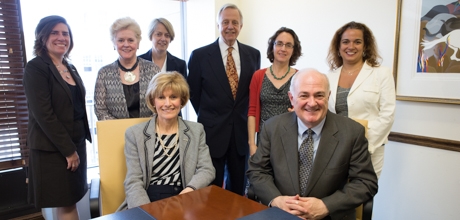The George Washington University signed a memorandum of understanding on Thursday to produce a joint lecture series about women’s history with the National Women’s History Museum. George Washington President Steven Knapp and NMWH President and CEO Joan Wages signed the agreement.
A series of four lectures—two in the fall semester and two in the spring—will focus on topics like women effecting change, women in the military and women in entrepreneurship. Speakers will be leaders in their fields and will present both historical and contemporary perspectives.
"We’re delighted to embark on this partnership with the National Women’s History Museum,” Dr. Knapp said. “The museum is a cultural institution devoted to an important subject area that is not only of great interest to our students, but also a focus of many of our departments and programs — from our Global Women’s Institute and Women’s Leadership Program to our women’s studies and history departments.”
In remarks after the signing, Ms. Wages emphasized that women’s history has largely been left out of American textbooks, museums and public life. “There are 17,000 museums in the United States and 56,000 in the world, and not one of them covers the scope of women’s history,” she said.
“Only 8 percent of statues in our nation’s parks are of women, and only 15 of the 217 statues in our nation’s capital are of women leaders. We are really looking forward to working, though this partnership, to get women’s history out into the public.”
The collaboration is an important step for the museum, which is currently lobbying Congress to help fund a brick-and-mortar home. The museum’s exhibits are all online, and members of the public are surprised to find out that they can’t go visit a national women’s museum, Ms. Wages said.
“The response we often get is ‘What? There isn’t one?’” she said. “Our mission is to bring women’s history into mainstream culture, and with every program we do, more people know about our effort. We’re building a groundswell of support.”


